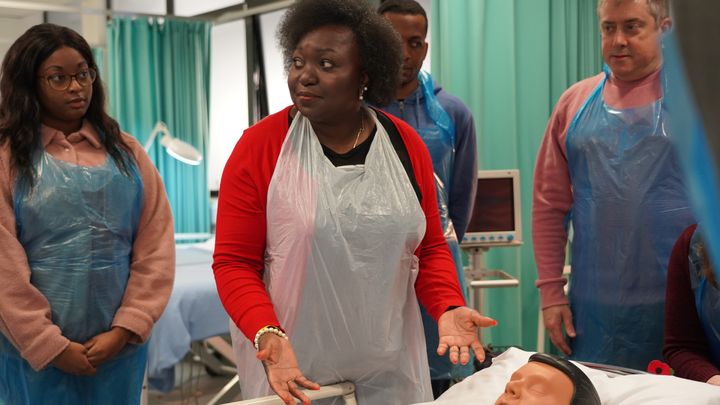Further Education (FE) teaching is a hugely varied profession. There are many ways to start, a wide range of subjects to teach (from legal to engineering to digital), and lots of options for how to fit it into your schedule. You can choose full-time positions or part-time roles that work around your current industry career.
While no two FE teaching roles look the same, there is always one key commonality: Your industry experience and skills will help inspire the next generation of learners in your field.
Read on to discover some of the key reasons why two FE teachers with experience working in digital and health & social care love sharing their skills.

At its core, FE teaching is a meaningful way to share your skills with the next generation of learners.
The beauty of entering the FE sector is that all of your hard-earned experience in the workplace can translate into your role teaching, encouraging and shaping learners’ minds. Ellisha Soanes feels strongly that her industry experience paved the way for her FE career. She did her teacher qualification while working, qualifying as a teacher in health and social care, and then expanded her remit overseeing equality, diversity and inclusion for three different colleges. It was a colleague of Ellisha’s who initially put the idea of FE teaching into her mind:
“From working in social services, probation services and the care sector, I’ve always worked with people and love it,” she explains.
“I used to do lots of training with staff on different elements: We’d talk about safeguarding, equality, diversity and inclusion — it’s always been a big part of what we do in person-centred care. One day, a staff member said, ‘You’re really good at these teaching elements,’ and I thought, Hmm, okay. Going into teaching could suit me.”
For anyone curious about FE teaching, Ellisha has one piece of advice she always dishes out: “Having that industry-based experience is fundamentally important. The students in the FE sector want to learn. They are going into specific areas — like hairdressing or social care — because they want a career in these areas. They really value you as a leader. I can tell you so many times where I’m training the next generation of nurses and social workers, giving them examples from industry-based experience, and their faces light up.”
“You [teach] because you want to shape and support people’s potential, so that they can be the next game changers in what they do. It’s lovely how you see your students flourish.”
As well as helping others to learn, Ellisha discovered that the interactive nature of FE teaching meant that she could continue to learn from her students as she develops her FE career. “I fundamentally feel in education, we’re shaping, we’re learning, we’re changing along the way — it’s about educating yourself and educating others, too. Let them [your students] teach you a few things.”

Your industry skills mean that you could start teaching right away.
One of the most interesting aspects of FE teaching is how varied it is in terms of the people who go into the profession, the many courses you can teach, and the path you can take to get there.
Vincent Wammy, a London-based freelance videographer and photographer who has been working as teacher in Further Education in animation & game design, film production and digital art for the past six years, became a teacher unexpectedly after a lecturer left the college where he was working as a technician (alongside his day job, filming events for clients).
“I was able to teach part-time while maintaining some of my role as a technician at the institute and also study part-time during each week for this period. There were naturally parts my studying would intersect with — my teaching and my college employer were happy to facilitate by freeing up my timetable to fit these all in,” he explains, noting that teacher training courses for FE require a set number of contact hours a week and include formal observations of your lessons.
“As with many things, it starts and progresses with a conversation. The FE provider I worked for was very helpful in my professional growth as a teacher and not only funded my teacher training courses, but provided support in the form of other teachers who would carry out the observations and evaluations I needed to pass my qualifications.”
If you’re interested in teaching, but worried you lack the qualifications, it’s worth noting that for many further education roles, you don’t necessarily need an academic degree or prior teaching experience to get started. Like Vincent, you can study for your teaching qualification on the job and start earning right away, and you may also be able to receive funding for your teacher training course.
Many of Ellisha’s colleagues entered the FE space looking for a career change or to work alongside raising children. “If you are a lone parent and you think, FE teaching is not for me, you should know that it’s a supportive and flexible career — the FE provider just wants you to thrive. Just do it, go for it. Lots of colleges and FE places are looking for people who have industry-based experience.”

You can continue to work in your industry alongside your FE teaching role.
While FE teaching offers a fulfilling career change for those looking for one, it also provides the flexibility for you to work part-time around your existing business or freelance career.
Vincent continues to take on freelance video and photography projects when he can, but notes that as he’s moved from part-time to full-time FE teaching, his focus has shifted away from weekslong video projects. He now primarily takes on photography and freelance art projects, and this year started teaching a vocational art group in addition to media classes.
“Having art commissions outside of teaching has given me a new focus in what I teach these students, as my day-to-day art processes bleed into my classroom teachings,” he explains.
While balancing freelance work with teaching “means having to weigh up your time and be realistic about your limitations within changing working conditions,” Vincent relishes the opportunity to do outside work he finds interesting and fulfilling.
“Professional development and building working relationships with like-minded individuals are great parts of the job and have really contributed to my continued skill set development. FE teaching has helped me with my personal development as I’ve navigated the professional world.”

Finally, the joys of the job make it a rewarding and fulfilling way to share your skills.
Ellisha has found fulfilment through various aspects of her FE career: watching her students go off into the real world as health and social care workers, affecting curriculum change (especially concerning matters of diversity and inclusion), and watching her own career transform. “It’s been amazing. I started off in lecturing and now I’m one of the group directors of three colleges and a university.”
“It’s been well worth teaching in FE for the joy it’s brought me,” says Vincent. “If you want to change other people’s lives for the better, then it’s a valid pathway that can fulfil those kinds of desires. Six years into teaching, I still enjoy the challenges that rear their heads weekly. There’s always a new creative resource design problem to solve, a young learner who needs that extra push or a chance for me to leave my stamp in the classroom.”
For Vincent, Ellisha and many other FE teachers, the true joy of the job comes from watching their students flourish, conquer their own insecurities and setbacks, and get out into the world to pay it forward with their new skills and knowledge.
“The best part of my career in FE teaching so far has to be when it comes time for end-of-year results. My learners consistently achieve their potential. Knowing that I’ve succeeded in drawing out the best from my learners is part of the joy, as at the end of the year I personally dish out their final grades and see their successes first hand,” Vincent says.
“Mainly it’s a joy to see them being able to navigate the world better than they did when they first arrived in my hands. It’s powerful stuff when you receive a surprise visit from an alumni who comes back to share their stories with you.”
Use your existing industry-experience, teach part-time alongside your current job, and make an impact by becoming a further education teacher. Find out more here.